SB 375 Mid-course Progress Review: From Vision to Implementation
SB 375 Mid-course Progress Review: From Vision to Implementation
Six years have passed since passage of SB 375 (Steinberg), California’s Sustainable Communities and Climate Protection Act of 2008. Six years also separate us from 2020 – a key milepost of AB 32 (Núñez and Pavley), the landmark climate change law that motivated SB 375.
At the halfway point toward SB 375’s first major milestone, it is timely to reflect on the progress and challenges for moving regional visions towards local implementation.
SB 375 has provided a platform to engage diverse stakeholders and plan for complete communities with a better mix of diverse housing, businesses and transportation choices.
With sufficient investments and the right implementation measures, we can create great communities where people of all ages and abilities can walk, bike and ride transit to the places where they live, work and play.
Local governments are instrumental to successful SB 375 implementation. Decisions about transit-oriented development, infill projects, and bicycle and pedestrian infrastructure happen at the local level, and are critical components to achieving regional goals.
This article will focus on one critical element of these broader implementation efforts: increasing growth in existing communities through infill development.
Many local governments in California have policies to support infill, sites identified and environmental analyses prepared for development. According to the annual planning survey by the Governor’s Office of Planning and Research:
- 64% of jurisdictions have policies and programs that encourage infill.
- Nearly one-third of them (32%) have identified areas for local infill.
- Over 50% have conducted an environmental analysis of the effects of infill development.
Nevertheless, local governments face many barriers to get projects in the ground, including infrastructure constraints, lot size and configuration issues, lack of funding, the overall economy and community opposition.
- 25% of jurisdictions reported that infrastructure constraints were a primary barrier to implementing infill projects.
- Nearly 25% had problems assembling parcels of the right size and configuration for infill development.
- Over 15% said lack of funding was a primary obstacle, while another 15% cited the economy and community opposition as major factors.
To overcome these barriers, local policymakers will need to take steps to even the playing field for local development and work with community members, property owners, developers and financial institutions to build support for infill projects.
Evening the Playing Field for Infill
Local governments should assure that competing greenfield developments pay the true costs – capital costs and ongoing operations and maintenance expenses. They can also make downtown and transit-oriented development more attractive by upgrading infrastructure, improving design and amenities, and providing more flexible zoning.
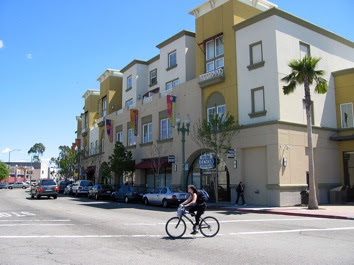
Photo Credit: LGC
The Local Government Commission has been working with the Council of Infill Builders to conduct forums throughout the San Joaquin Valley, highlighting findings from their new report Bringing Downtown Back: Ways to Boost Infill Development in the San Joaquin Valley. The report describes ways that Valley leaders can restore their historic downtowns and overcome the barriers that led to the current deterioration and economic challenges prevalent across many Valley neighborhoods. The findings resulted from a convening of Valley land use experts and officials in Fresno.
Priority recommendations developed by the group include:
- Improving urban design and expanding amenities, such as encouraging a “pop-up culture” of food trucks and art shows and allowing more experimentation and temporary permits for activities that bring residents into downtown neighborhoods.
- Flexible zoning that allows for new product types and catalytic interim uses for existing buildings or public spaces to encourage revitalization in key infill areas.
- Regional and local prioritization of infrastructure in infill areas, such as parks, utility upgrades and sidewalks, as well as upgrading and performing deferred maintenance on public infrastructure, based on municipal assessments and master planning for infrastructure needs.
- Air district funding to finance catalytic infill projects that will reduce driving and air pollution by reviving downtown neighborhoods.
- Tiered or differential development impact fees that account for the true fiscal and environmental burdens of outlying projects and encourage new projects in infill neighborhoods.
Building Support for Infill Projects
Infill projects can create polarizing debates among developers, environmental groups and community members. These conversations are raising a number of important questions about quality of life, community fabric, increased amenities, traffic and air quality impacts, and affordable housing.
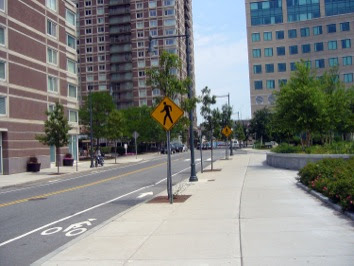
Photo Credit: LGC
These important neighborhood concerns must be considered in the context of a larger regional need to meet state mandates, achieve environmental goals and optimize jobs-housing balance. It is no surprise that these needs are not always aligned, creating opposition – particularly for development projects in existing neighborhoods – which are the same infill areas that development should be focused in under the region’s Sustainable Community Strategy (SCS).
The threat of community opposition compounds existing barriers to infill such as smaller parcel sizes, old infrastructure, lack of financing, and a complex building and regulatory environment to create a perverse disincentive for mixed-use, infill development.
There are many good reasons why a home or business owner might not want to see a particular development in their backyard. However, the real question we should be asking the public is what type of process or project would compel them to say “Yes, build that in my backyard!”
 Recent initiatives such as Popularise and Fundrise are gaining recognition among conservative and progressivecircles (from NY
Recent initiatives such as Popularise and Fundrise are gaining recognition among conservative and progressivecircles (from NY  Times and Washington Post to Fox) and providing new ways for community members to invest in local projects with their ideas, their votes and their dollars.
Times and Washington Post to Fox) and providing new ways for community members to invest in local projects with their ideas, their votes and their dollars.
New York YIMBY, a popular new blog that catalogs infill sites and serves as a forum for pro-development discussions, attracts 75,000 visitors monthly. The New York Times has called it a “lively, chatty site that is catnip to fans of the city’s ever expanding forest of high-rises.”
Promising opportunities – whether through traditional tools like community image surveys or more nonconventional mechanisms that use new technology – are evolving and expanding at a time when demographic changes reflecting shifting community preferences and environmental awareness are aligning to increase support of smart growth.
According to the 2013 Community Preference Survey by the National Association of REALTORS®, 60% of respondents favor a neighborhood with a mix of houses, stores and other businesses that are within walking distance over neighborhoods that require driving between home, work and recreation. While the size of a home or yard does matter, most respondents said they are willing to compromise size for a preferred neighborhood and shorter commutes.
The last Public Policy Institute of California’s annual survey on the environment showed that a large majority of Californians view global warming as a very serious threat (50%) or somewhat serious threat (27%) to California’s future economy and quality of life. And the number of Californians (65%) who said the state government should act right away to reduce greenhouse gas emissions, rather than wait until the economy and job situation improve, hit a record high.
Given the growing nexus between changing community preferences and urgency around environmental protection, what would it take to see this general support reflected as enthusiasm at the neighborhood scale for projects aligned with smart-growth goals and growing housing demand?
Seeding the Ground for Infill
Bringing together key players in the region – developers, banks, local policymakers, downtown business associations and community leaders – could start to address that question.
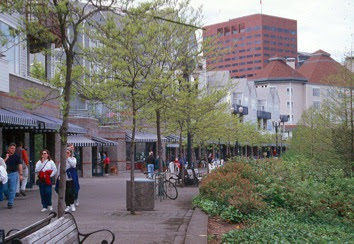
Photo Credit: LGC
Presentations on new tools, initiatives and successful public processes that lead to popular infill projects could set the stage for a discussion on how to create a conducive environment for infill in the region. This timely conversation could inform the process for future development projects but also start to shift perspectives in advance of the next SCS.
Regional grant programs, such as OneBayArea and the Southern California Association of Government’s Compass Blueprint and Green Region initiative, can also help spur local SCS planning around transit-oriented development and priority infill sites.
The Council of Infill Builders report provides a number of recommendations for the state as well as including an improved state infrastructure bank that could provide loans to local governments that plan for and support infill infrastructure. Restoring and expanding tax-increment financing for urban projects and lowering the voter-approval threshold for forming infrastructure financing districts from two-thirds to 55% will be critical as well. Lastly, the state should prioritize funding from cap and trade revenue for transit and local projects that reduce emissions and spur innovation.
Changing level of service, which has long punished compact development, is another step in the right direction. For more information on efforts by the Governor’s Office of Planning and Research to amend the CEQA Guidelines to provide an alternative to LOS for evaluating transportation impacts, click here.
New Fiscal Tools Foster Better Plans, Save Money
Fiscal impact tools, such as RapidFire, UrbanFootprint or iMPACs, can also help build support for focusing growth in existing communities by highlighting the local economic and environmental benefits of smart growth.
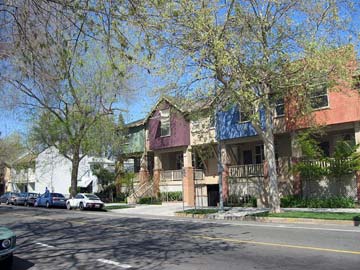
Photo Credit: LGC
The iMPACS infrastructure cost model was used during the Sacramento Area Council of Government’s (SACOG) Blueprint process and showed the region could save $13.8 billion through the Preferred Alternative rather than the Base Case over the next 50 years. More than half of this savings would result from having to purchase far less land to mitigate the consumption of agricultural and habitat lands. The remaining savings result from the need for less infrastructure to serve the same number of residents and workers.
The Southern California Association of Governments used RapidFire to do a similar analysis for its Sustainable Community Strategy scenarios of the impacts to jobs, working lands, public health costs, air quality, vehicle miles traveled, and water and energy use. The City of Fresno also used RapidFire to choose their general plan alternative.
Leading the Way
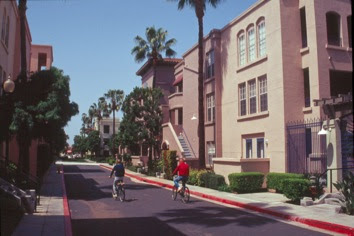
Photo Credit: LGC
We’re off to a good start – many communities have adopted supportive policies and implemented catalytic urban projects – but we’ve got a ways to go to truly even the playing field for compact development, build community support and achieve the regional sustainable community visions and 2020 climate goals.
The LGC is committed to working with the state and supporting local governments to ensure that the community visions represented through the sustainable community strategies come to fruition. This fall, we are partnering with the state to roll out a new statewide AmeriCorps initiative – called CivicSpark – to assist local governments on projects to implement SB 375 that will improve climate resiliency and increase clean energy.
The rest of the nation is watching and waiting to follow our lead.
Local Government Commission Newsletters
Livable Places Update
CURRENTS Newsletter
CivicSpark™ Newsletter
LGC Newsletters
Keep up to date with LGC’s newsletters!
Livable Places Update – April
April’s article: Microtransit: Right-Sizing Transportation to Improve Community Mobility
Currents: Spring 2019
Currents provides readers with current information on energy issues affecting local governments in California.
CivicSpark Newsletter – March
This monthly CivicSpark newsletter features updates on CivicSpark projects and highlights.



